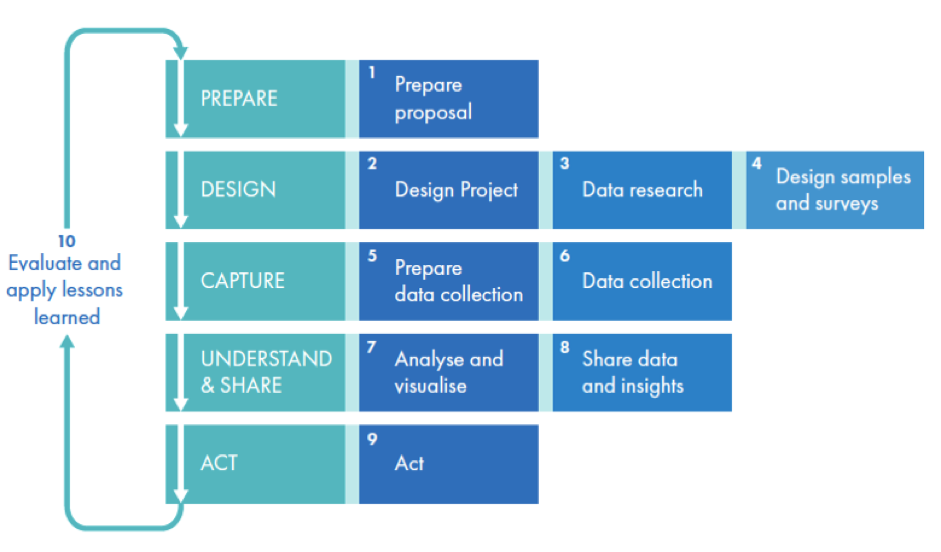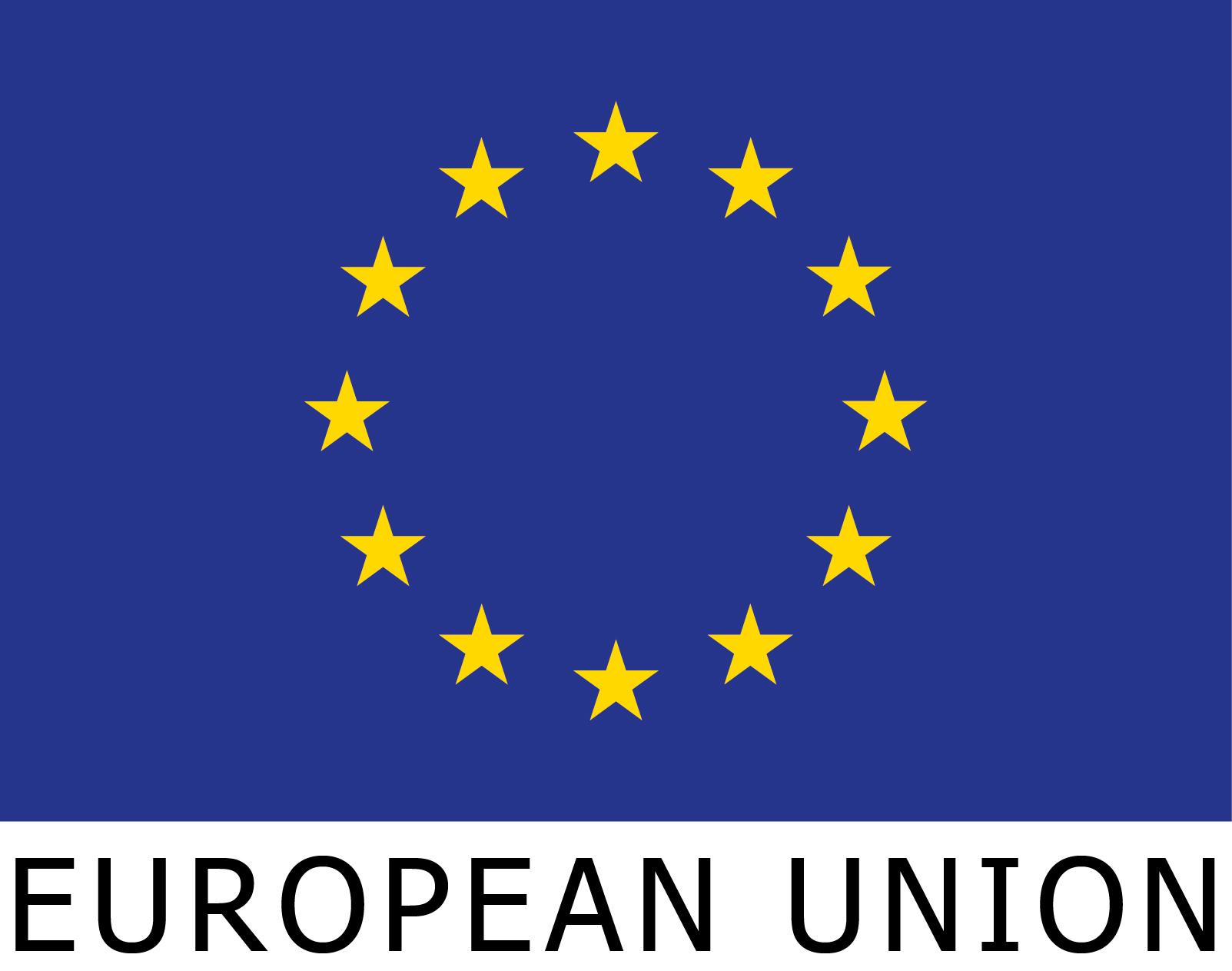Handbook on Data Collection / Phase Nine: Make Informed Decisions
| |

Growing opportunities in data collection and analysis have led to changes in the way people make decisions. Data to decision (D2D) refers to the practice of basing decisions on the analysis of data rather than on preconceptions, opinions, and other influencing factors.
To improve the decision-making process, several types of D2D models have been developed over the years, such as fact-based decision making, rational decision making, and ethical decision making. Fact-based decision making is one of the most commonly used to make informed decisions, because it places emphasis on the gathering of facts, figures, data, and evidence. Practice of this model allows decision makers to monitor the outcomes of policies and the national progress towards the sustainable development goals.
Each phase of the Handbook is designed to prepare those involved in the project for data-informed decision making:
|
1. Prepare project |
Prepare the project proposal. |
|
2. Design project |
Design the project in detail, together with (local) stakeholders. |
|
3. Research data |
Research what data is already available and what this means for the data to be collected. |
|
4. Design samples and surveys |
Design the sample in which data will be collected and the survey to be used. |
|
5. Prepare data collection |
Prepare for data collection in the field. |
|
6. Collect data |
Manage the data collection in the field. |
|
7. Analyse and visualise data and gain insights |
Analyse and visualise the gathered data, combine with other data sources and gain insights. |
|
8. Share data and insights |
Share the gathered data and insights publicly. |
|
9. Make informed decisions |
Make informed decisions based on the insights developed. |
|
10. Evaluate and apply lessons learned |
Evaluate the project and apply any lessons learned in the follow up. |
Informed decision making is only possible when the appropriate data or evidence is available. Thoroughly researching the data needs to be done in phases two and three, followed by the collection of data in phases four to six. The data processing in phase seven is done with the target audience in mind so that the data and the conclusions drawn are relevant for the decision makers. Data and insights are then shared in phase eight so that any relevant parties can make use of it.

Contents
The opportunity D2D presents
The success of the D2D process is influenced by three main factors. First, there are the type of decisions that can be made (policy changes, organisational restructuring, funding decisions) based on the facts, the supported statistics, and the tested intuition. Secondly, the communication of decisions to stakeholders, and lastly, the execution of the decisions. This process provides higher levels of transparency and better awareness about decision making. By leveraging the use of data across the organisation, decision makers can enable effective risk analysis, enhancing organisational resilience and risk management. Of course, the data must be valid and the organisation must have the human resources with the skills and capabilities to analyse the data in a transparent way.
Best practices
Health sector
The overall aim of World Health Organization (WHO) is to articulate specific interventions that can improve the demand for and use of data in decision making, so that improvements in health systems can be realised. There are several examples in which WHO have used D2D to more effectively target limited surveillance, prevention, and control resources and to reduce vector-borne and other infectious diseases such as mosquito-borne dengue and malaria. 2
Water sector
Higher temperatures and changes in extreme weather conditions are predicted to affect availability and distribution of rainfall, river flows, and groundwater and further deteriorate water quality. Adaptation to climate change is closely linked to water and its role in sustainable development. During the droughts of 2016 and 2017, Akvo has worked together closely with the Ethiopian government and other key WASH partners such as UNICEF to map water infrastructure in the most affected drought-prone areas in order to build up a national database of water point functionality and to monitor these water points at regular intervals. This information has been used to address food security and a humanitarian response to minimise the risks and vulnerabilities generated by serious drought.3 Another example is from Tanzania where the government is implementing D2D to increase access to water from 53% in 2005 to 90% by 2025.4
Challenges of D2D
Lack of organisational capacity to be data driven
There is a growing appetite among organisations for data and data-driven decision making despite their struggles with several issues. Many organisations and governments working in the development sector do not have the resources and capacity to design data collection schemes or to clean, analyse, and use data. Furthermore, data is often collected using inconsistent methodologies and located in fragmented sources, which do not integrate well with existing government systems. This means that data and insights are not stored in a structured way, which makes it hard to access for future use and hampers building an institutional memory.
Unwillingness to use facts
There is often no willingness to accept data-driven decision making. Especially in political processes, conclusions drawn from facts may contradict the interests of certain groups, parties, or individuals. This influence may be stronger than anticipated and the data or insights may be manipulated to fit specific interests. It is therefore important to be aware of this risk, to detail the risk and develop strategies to reduce the risk. A method that can be used is stakeholder mapping, which is detailed in phase two of the Handbook.
Data quality challenges
There is a range of issues regarding data quality which can stop it from being used. It may be incomplete, and therefore unfit for analysis. Without analysis, gathering insights for decision making isn’t possible. As described in phase three (data research), there are four key factors to consider when evaluating data: accessibility, granularity, credibility, and relevance. Being aware of these factors and the associated challenges allows you to plan for high quality data collection in the design phase of the project.
Involving communities in decision making
There are multiple advantages and disadvantages of community participation in a decision-making process. According to research conducted by R. A. Irvin and J. Stansbury, the advantages include interactive learning from citizen and government, building trust between citizens and project leaders, gaining legitimacy of decisions made, and gaining help with the implementation of decisions. Disadvantages include cost, the possibility of a process backfiring and creating hostility, opposing interest groups, and government loss of control over decision making.5
Conclusion
Data-driven decision-making is necessary for good governance. It allows organisations to take prompt action, which may avoid or reduce financial risk and enhance transparency in the use of information. In this article, we described the importance and challenges of the D2D process. We also outlined four phases of the D2D process: establishing the organisational need, using the right tool for data collection and pre-processing the data, data analysis -- interpreting and deriving the insights from the data, and making a final judgment. Case study results from the health and water sector confirm that D2D has been successful in improving services.
Suggested reading
- Informed Decision-making: You Should Be Getting More Value From Your Data
- Using Data to Influence Government Decisions : Opportunities and Challenges for User-Centered Design to Improve Governance Data Impact
References
- ↑ A. Acharjee, “Data, big data and data driven decision making strategy: Part 1,” 2008.
- ↑ L. M. Barat, “Four malaria success stories: how malaria burden was successfully reduced in Brazil, Eritrea, India, and Vietnam,” Am. J. Trop. Med. Hyg., vol. 74, no. 1, pp. 12–16, 2006.
- ↑ Government of Ethiopia and UNICEF compile national water & sanitation inventory
- ↑ R. Giné and A. Pérez-Foguet, ‘Sustainability assessment of national rural water supply program in Tanzania’, Nat. Resour. Forum, vol. 32, no. 4, pp. 327–342, 2008.
- ↑ R. A. Irvin and J. Stansbury, ‘Citizen Participation in Decision Making: Is It Worth the Effort?’, Public Adm. Rev., vol. 64, no. 1, pp. 55–65, 2004.
Acknowledgements
Authors: Arun Kumar Pratihast (Akvo.org), Marten Schoonman (Akvo.org)
Contributors: Harro Riedstra (Akvo.org), Lars Heemskerk (Akvo.org), Mamohloding Tlhagale (Water Research Commission, WRC)
AfriAlliance
| The Africa-EU Innovation Alliance for Water and Climate (AfriAlliance), is a 5-year project funded by the European Union’s H2020 Research and Innovation Programme. It aims to improve African preparedness for climate change challenges by stimulating knowledge sharing and collaboration between African and European stakeholders. Rather than creating new networks, the 16 EU and African partners in this project will consolidate existing ones, consisting of scientists, decision makers, practitioners, citizens and other key stakeholders, into an effective, problem-focused knowledge sharing mechanism. |
| AfriAlliance is lead by the IHE Delft Institute for Water Education (Project Director: Dr. Uta Wehn) and runs from 2016 to 2021. The project has received funding from the European Union’s Horizon 2020 research and innovation programme under grant agreement No 689162. |

